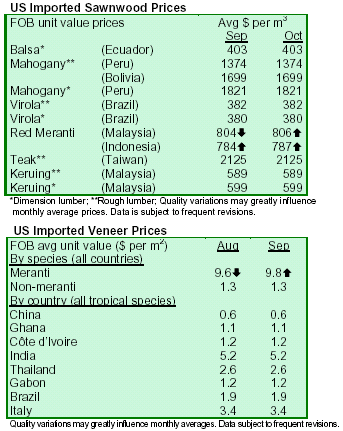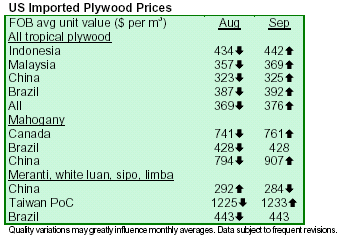|
Lennar to cut construction by 20%
Lennar, the third-largest US homebuilder, has recently forecast it would cut construction by 20% this year in a bid
to clear excess market supply and counter the collapse in margins at the end of 2006. The Miami-based group
warned that the US housing market remained depressed, but unveiled a series of measures designed to bolster
earnings despite writing down the value of its land holdings and options. Lennar and its rivals have been
cutting production and boosting discounts to shift an inventory of unsold houses which had stretched to more
than nine months by the end of 2006. Lennar admitted that sales incentives depressed the average sales price and
pulled down margins from 27% to 14.4% over the last quarter of 2006.
Industrial wooden panels in North America
Engineered wooden boards can be segregated in two broad categories: (i) structural boards and (ii) non-structural or
industrial boards. Structural boards are used predominantly in house construction and include products
such as plywood and OSB. Industrial boards are widely
used in the furniture and cabinet industry. Particleboard, MDF and hardboard are representatives of this category.
There are some overlaps in these products. For instance, much of the lower grade plywood is used for housing
purposes, while the upper grades are more often used for
industrial purposes.
In this first article, the production capacity for industrial wooden panels in the USA, Canada, and Mexico and the
changes that occurred between 2005 and 2006 are discussed.
USA
Last year, the American industrial capacity of particleboard stood slightly in excess of 9 million m3, up
3.5% from 2005. The vast majority of particleboard producers in the USA either
maintained or slightly increased their operating capacity in 2006. The capacity
increase has been further boosted by the re-opening of two mills in Virginia: Stuart Forest Products LLC in Stuart
and Waverly Particleboard Company, LLC in Waverly. The southeastern USA comprises now 40% of the overall
American particleboard capacity. No other region in North America has the same dominance as the South East, with
eight of the top fifteen particleboard producing
states/provinces (on the basis of aggregate capacity) being in this region.
The average operating rate (shipments as a percentage of capacity) of all US particleboard plants was 82% in 2005.
Last year, the operating rate declined to approximately 79%. This deterioration can be attributed only partially to
the higher industrial capacity. The main reason is the shrinking American furniture production, resulting from
the growing competition from offshore furniture suppliers. With the furniture industry being a major end-user of
particleboard, it is not surprising that the demise of the US furniture industry manifests itself in a lower capacity
utilization of particleboard mills.
Similar to particleboard, the American capacity of
MDF, also increased between 2005 and 2006. It stood at 3.9 million m3 in 2005 and advanced to over 4 million m3 in
2006. The increase of 2.7% or some 100,000 m3 was primarily due to the restarted Paragon Panels facility in
Eufaula, Alabama. Of the 18 existing American MDF facilities, three increased and two decreased their
production capacity. The remaining companies did not experience any change from 2005 levels. The average
operating rate for US MDF mills stood at 86% last year, virtually unchanged from the 85% the year before. This is
a very satisfactory performance and higher than for any other wood panel industry (particleboard, hardboard,
OSB, plywood). While the overall output did not change much, the composition of the end-users underwent noticeable
modifications. An increased usage by the laminated flooring industry has been offset by a lesser usage in the
furniture industry.
American hardboard capacity stood at 1.55 million m3 in 2006, down 2.5% from the 1.59 million m3 in 2005. In
spite of some 30,000 m3 of mothballed capacity, the industry continued to suffer a decline in its utilization rate
from 81% in 2005 to only 77% last year. The main reasons for the decline are the continued loss of market share to
thin MDF products. Furthermore, the lesser usage of hardboard in the residential construction, repair and
remodeling sectors as well as in the furniture industry are additional negative factors.
The overall American capacity of particleboard, MDF and hardboard advanced from 14.21 million m3 in 2005 to
almost 14.58 million m3 in 2006. The difference of about 365,000 m3 represents an increase of 2.6%. The main
growth contributor was particleboard, both on an absolute (301,000 m3) and relative (3.5%) basis. MDF also
recorded a positive change but hardboard was a ¡°drag¡± on overall capacity.

Canada
The Canadian particleboard capacity stood at 3.9 million m3 in 2005. Last year was a
restructuring year for this industry, with business conditions leading to the closure of
four plants and partial closure of one plant. The closures were due to a host of factors including the strong Canadian
dollar, increased energy costs, and a shortage of available fiber supply. In the case of an agricultural fiber-based
plant there was also a lack of market demand. The circumstances resulted in a 28% or 1.1 million m3
reduction in production capacity compared to 2005. Of the
ten remaining operational facilities, only some 2.8 million m3 of productive capacity is still available in Canada at the
present time. In spite of the lower capacity, the average operating rate for Canadian particleboard mills fell
moderately from 81% in 2005 to about 80% in 2006.
MDF production capacity at Canadian facilities increased 2.5% or 42,000 m3 from 1.71 million m3 in 2005 to about
1.75 million m3 in 2006. Of the seven plants, three expanded their capacity, one reduced it and the other
remained at the same year-over-year level. The average operating rate for Canadian mills in 2005 was 84% and
89% in 2006. The 5% improvement was the result of an increased focus by Canadian producers on thin
MDF, flooring, and other value-added products. Similar to the USA, Canadian hardboard capacity declined in 2006.
Aggregate capacity for the three existing facilities decreased 2.6% or 4,000 m3 from 151,000 m3 to 147,000
m3 between 2005 and 2006.
The combined Canadian capacity of particleboard, MDF and hardboard fell from over 5.7 million m3 in 2005 to
approximately 4.7 million m3 last year. Compared to the 2.6% increase in the USA, the 18.4% drop of the Canadian
capacity, equivalent to slightly more than one million m3,
is relatively steep and surprising. Almost all of the contraction goes on account of particleboard.
Mexico
Production capacity for Mexican-based particleboard producers decreased by 4% or 37,000 m3 from 920,000 m3
in 2005 to an estimated 883,000 m3 last year. The MDF capacity in Mexico remained with 35,000 m3 unchanged
during this same time span. Hardboard production is very
small in Mexico and of little relevance. The total capacity for the three wooden panels stood at 955,000 m3 in 2005
and fell 3.9% to 918,000 m3 in 2006.


|